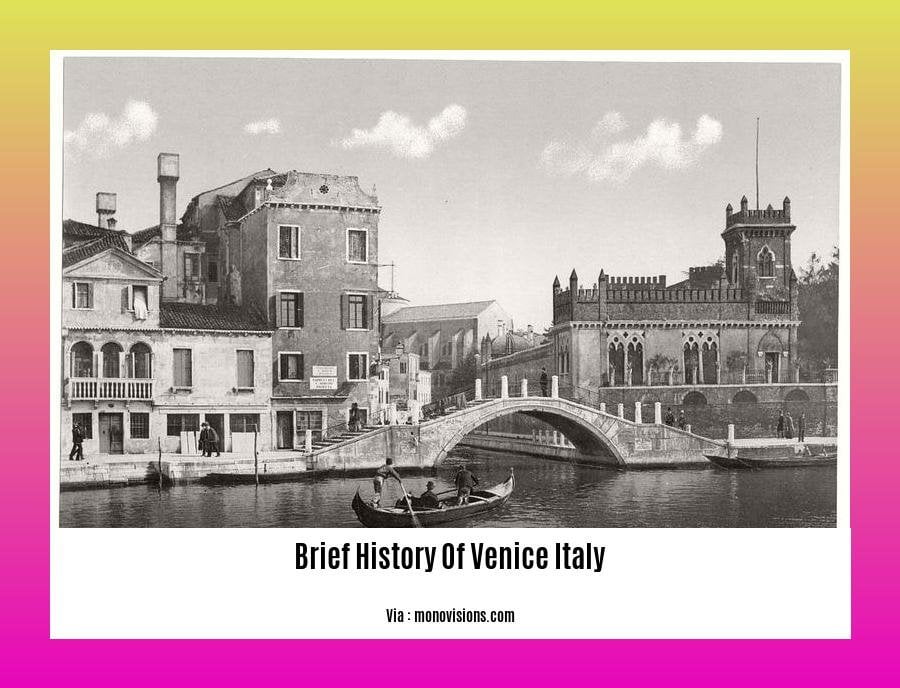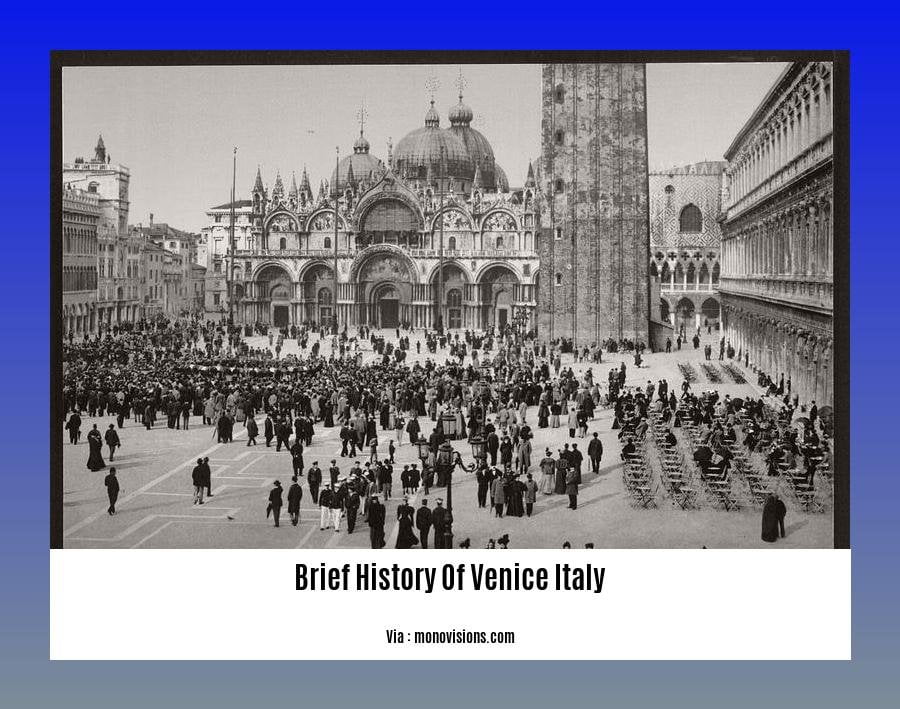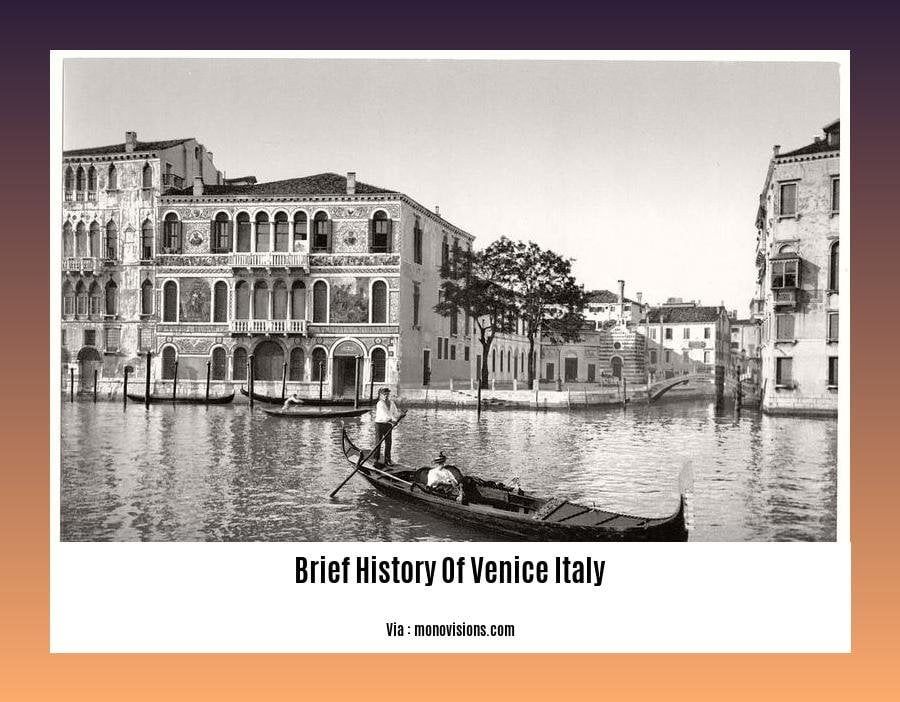Step into the enchanting world of Venice, Italy, where history, art, and architecture intertwine to create a city like no other. In our exploration titled [[Brief History of Venice Italy]: A Journey Through Time and Wonders], we’ll uncover the stories behind its iconic landmarks, from the majestic Doge’s Palace to the breathtaking Grand Canal, and introduce you to the remarkable individuals who shaped Venice’s destiny. Join us as we embark on a captivating voyage through the past, revealing the secrets that make Venice a timeless treasure.
Key Takeaways:
Venice’s foundation in 421 AD was driven by refugees seeking shelter from invasions, choosing to settle on the islands of the lagoon.
Venice’s rise as a maritime and trade powerhouse in the Mediterranean spanned over a millennium, involving alliances and conflicts with various states like the Byzantine Empire, Lombards, and Croats.
Venice’s diverse cultural and artistic legacy reflects influences from civilizations encountered throughout its history due to its extensive interactions during its maritime prominence.
Brief History of Venice Italy

Venice, Italy, the city of canals and romance, is a floating masterpiece with a captivating history that spans over a millennium. Let’s dive into the treasure chest of Venetian history, unearthing the stories behind its rise, struggles, and enduring charm.
Humble Beginnings
In the 5th century, as barbarian hordes swept across Europe, refugees from the mainland sought refuge on the marshy islands of the Venetian lagoon. These resilient settlers laid the foundation of a city that would become a maritime and commercial powerhouse.
Flourishing Republic
Over the centuries, Venice emerged as a thriving republic, its wealth and influence growing with each passing decade. Its strategic location at the crossroads of the Mediterranean allowed it to flourish as a trading hub, connecting East and West. The city’s unique system of government, led by a Doge, ensured stability and prosperity, making Venice a beacon of hope in a tumultuous world.
Artistic and Cultural Legacy
Venice became a haven for artists and intellectuals, attracting some of the greatest minds of the Renaissance. The city’s opulent palazzi, adorned with intricate frescoes and sculptures, showcased the genius of masters like Titian, Tintoretto, and Veronese. The vibrant cultural scene, fueled by the exchange of ideas from across the globe, laid the foundation for Venice’s enduring artistic legacy.
Decline and Adaptation
As trade routes shifted and new powers emerged, Venice’s maritime dominance waned. However, the city adapted to the changing times, transforming itself into a center of tourism and cultural heritage. Its unique charm, preserved through centuries of careful conservation, continues to captivate visitors from around the world.
A City Immortalized
Venice’s beauty and significance have been immortalized in art, literature, and music. From Shakespeare’s plays to Vivaldi’s concertos, the city’s allure has inspired countless artists to create masterpieces that celebrate its timeless essence.
Venice, with its canals, palazzi, and captivating history, stands as a living testament to the power of human ingenuity and resilience. Its legacy continues to inspire, showcasing how a city built on water can withstand the tides of time, embodying the enduring spirit of Italy’s “Queen of the Adriatic.”
If you’re inquisitive about Nigeria’s historical backdrop, then this brief history of Nigeria from 1960 till date is a must-read.
Unravel the captivating account of Venice’s origin and evolution through this comprehensive brief history of Venice .
Dive into the intriguing narrative of the California Angels’ iconic hat, tracing its journey through time in this captivating piece California Angels hat history.
The city flourished as a maritime power and its maritime prowess in Mediterranean trade and defense

Venice, a city built on a lagoon in the Adriatic Sea, emerged as a significant maritime power in the medieval and early modern world. Its strategic location at the crossroads of trade routes between East and West, coupled with its maritime prowess, played a pivotal role in shaping its historical significance and cultural legacy.
Birth of a Maritime Power
Venice’s maritime power began to take shape in the 9th century, when it secured trading rights along the Adriatic coast from the Byzantine Empire. This strategic move allowed Venetian merchants to establish trading networks throughout the Mediterranean, gaining control of key trade routes and fostering economic growth.
Rise to Prominence
In 1082, Venice declared independence from the Byzantine Empire, becoming a powerful maritime republic. The city’s unique form of government, led by a doge, ensured stability and prosperity, enabling Venice to expand its influence and become a dominant force in Mediterranean trade.
Maritime Prowess and Trade Supremacy
Venice’s maritime prowess stemmed from its advanced shipbuilding techniques and skilled navigators. Its fleet of sleek galleys, manned by experienced sailors, not only ensured dominance in trade but also provided effective defense against rival powers.
The city’s strategic location at the head of the Adriatic Sea gave it control over the eastern trade routes. Venetian merchants traded extensively with destinations such as Egypt, Syria, and Constantinople, bringing exotic goods like spices, textiles, and glassware to the European markets.
Venice’s Legacy: A Maritime Powerhouse
Venice’s maritime power played a crucial role in the development of the Italian Renaissance. The wealth generated from trade enabled the patronage of humanists, scholars, and artists, contributing to the flourishing of artistic and cultural expression.
The city’s maritime heritage can still be seen today in its iconic landmarks, such as the Doge’s Palace and St. Mark’s Basilica, which showcase the opulence and grandeur of Venice’s maritime past.
Key Takeaways:
- 9th Century: Venice secured trading rights along the Adriatic coast, marking the beginning of its maritime power.
- 1082: Venice became a republic independent of the Byzantine Empire, solidifying its status as a maritime power.
- Strategic Location: Venice’s location at the head of the Adriatic Sea allowed it to control eastern trade routes.
- Trade Dominance: Venetian merchants controlled key trade routes, bringing exotic goods from the East to European markets.
- Maritime Defense: Venice’s skilled navigators and advanced shipbuilding techniques ensured its naval supremacy.
- Cultural Legacy: The wealth from trade supported the Italian Renaissance, fostering artistic and cultural development.
Sources:
– UNESCO: Venice and its Lagoon
– Compass and Pine: History of Venice
Venice grew into a wealthy and powerful city, famed for its beautiful architecture, art, and canals
Venice, the enchanting city built on a lagoon in northeastern Italy, with its intricate canals, awe-inspiring architecture, and vibrant cultural heritage, is a true testament to the remarkable influence of art and commerce. The city, which started as a humble fishing village in the 5th century, rose to become one of the wealthiest and most powerful maritime republics in history.
In the 9th century, Venice’s strategic location at the crossroads of the Mediterranean and the Adriatic Sea allowed it to flourish as a maritime power. The city’s unique system of government, led by a Doge, ensured stability and prosperity. Venice became a hub for trade, connecting the East and West with its extensive network of trading posts stretching from the Mediterranean to the Black Sea.
Venice’s wealth and power attracted artists and intellectuals from across the globe, making it a haven for artistic and cultural expression. The city became a prominent center of the Italian Renaissance, producing some of the most influential works of art and architecture of the period, including the Doge’s Palace, St. Mark’s Basilica, and the Rialto Bridge.
The city’s unique architecture, shaped by the challenges of building on water, is a testament to the ingenuity of Venetian engineers. The Grand Canal, the city’s main waterway, is lined with magnificent palaces and churches, showcasing a blend of Byzantine, Gothic, and Renaissance styles.
Venice’s canals, a defining feature of the city, served as both a defense mechanism and a transportation network. The intricate network of waterways allowed for the efficient movement of goods and people, contributing to the city’s commercial success.
Despite its decline as a maritime power in the 17th century, Venice’s artistic and cultural heritage continued to flourish. The city became a popular destination for Grand Tourists, wealthy Europeans who traveled to experience the city’s rich history and architecture.
In the 19th century, Venice came under the rule of the Austrian Empire and later became part of the Kingdom of Italy. The city underwent a period of urban renewal and restoration, preserving its architectural treasures and attracting tourists from around the world.
Today, Venice stands as a living testament to its glorious past, a city where the echoes of its former wealth and power can still be seen in its stunning architecture, vibrant art scene, and the gentle lapping of the water against its canals.
Key Takeaways
Venetian architecture showcases a unique blend of Byzantine, Gothic, and Renaissance styles, reflecting the city’s rich history and cultural influences.
Venice’s wealth and power was primarily driven by its strategic location as a maritime hub, connecting the East and West through extensive trade routes.
The city’s unique system of government, led by a Doge, ensured stability and prosperity during its rise as a maritime republic.
Venice became a haven for artistic and intellectual expression during the Italian Renaissance, attracting artists and scholars from across the globe.
The city’s canals served both as a defense mechanism and a transportation network, contributing to its commercial success and unique character.
Despite its decline as a maritime power, Venice’s artistic and cultural heritage continued to flourish, transforming it into a popular destination for tourists and Grand Tourists.
Today, Venice remains a captivating city, preserving its architectural treasures, vibrant art scene, and the allure of its enchanting canals.
Sources:
Its Unique Political System, the Venetian Republic, Lasted for Over a Thousand Years
They say the enchantment of Venice, a city floating on water, is a concoction of its captivating past, breathtaking art, and wondrous architecture. The city’s heart, St. Mark’s Square, pulsates with stories of a republic that endured for a staggering thousand years.
Venice’s enduring political system, the Venetian Republic, stands as a testament to the ingenuity and resilience of its people. The republic’s longevity can be attributed to several factors, including:
1. Its Unique Governmental Structure:
- Venice’s government was a complex system involving the Doge, the Great Council, and the Senate.
- The Doge, elected for life, served as the symbol of the republic and presided over state functions.
- The Great Council, composed of noble families, held legislative power and elected the Doge.
- The Senate, a smaller body, handled day-to-day administration and foreign policy.
2. Its Emphasis on Trade and Commerce:
- Venice’s strategic location at the head of the Adriatic Sea made it a natural hub for trade between Europe and the Middle East.
- The republic’s merchant fleet dominated Mediterranean trade routes, bringing immense wealth and prosperity to the city.
- Venice’s trading prowess led to the development of a sophisticated financial system, including the establishment of the world’s first banks.
3. Its System of Collective Leadership:
- Venice’s government was characterized by a system of checks and balances, preventing any single individual or faction from gaining absolute power.
- This system ensured stability and continuity, allowing the republic to weather political storms and external threats.
Key Takeaways:
- Unique Political System: Venice’s unique political system, with its complex interplay of institutions and power-sharing mechanisms, ensured its longevity and stability.
- Trade and Commerce: The republic’s strategic location and focus on trade and commerce brought immense wealth and prosperity, fueling its rise to power.
- Collective Leadership: Venice’s system of collective leadership prevented the concentration of power and fostered a sense of shared responsibility among its ruling class.
Sources:
- History of Venice
- The Venetian Republic
FAQ
Q1. What were the early origins of Venice?
A1. Venice was founded by refugees from the mainland who sought shelter in its lagoon in 421 AD.
Q2. How did Venice become a maritime power?
A2. Venice gained trading rights along the Adriatic coast from the Byzantine Empire, which allowed it to establish itself as a significant maritime power in the 9th century.
Q3. What was Venice’s role in the Italian Renaissance?
A3. Venice’s wealth from maritime trade enabled the patronage of humanists, scholars, and artists during the Renaissance period, promoting cultural and artistic development in Italy.
Q4. What architectural influences shaped Venice’s unique style?
A4. Venice’s architecture reflects influences from the Byzantine Empire, Gothic Era, and its unique maritime history, resulting in a distinctive architectural style.
Q5. What was the Republic of Venice’s significance in history?
A5. The Republic of Venice existed for over a millennium, becoming a powerful maritime republic with extensive trade and territorial control, contributing significantly to the history and culture of the Mediterranean region.















